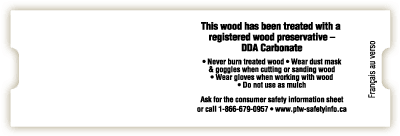Consumer Safety Information Sheet

Didecyl dimethyl ammonium carbonate (DDA Carbonate) Pressure Treated Wood
Didecyl dimethyl ammonium carbonate (DDA Carbonate) is a carbon-based wood preservative used in the pressure treatment of wood products for light-duty residential uses including, but not limited to, fencing.
DDA Carbonate penetrates into and remains in pressure-treated wood for a long time. However, some preservative may migrate from the pressure-treated wood into surrounding soil over time and there may be incidental contact with skin during construction or use.
Follow the safe practices listed below when working with pressure-treated wood. Specific work practices may vary depending on the environment and safety requirements of individual jobs.
Use
Wood pressure-treated with DDA Carbonate may be used inside residences as long as all sawdust and construction debris are cleaned up and disposed of after construction.
Do not use treated wood under circumstances where the preservative may become a component of food or animal feed. Examples of such sites would be structures or containers for storing silage or food.
Do not use treated wood for cutting boards or countertops.
Only use treated wood that is visibly clean and free of surface residue for patios, decks and walkways.
Do not use treated wood for construction of those portions of beehives that may come in contact with honey.
Do not use treated wood where it may come in direct or indirect contact with public drinking water, except for uses involving incidental contact such as docks and bridges.
Do not use treated wood for mulch.
Handling
Wear gloves to protect against splinters.
Wear a dust mask when machining any wood to reduce the inhalation of wood dusts. Avoid frequent or prolonged inhalation of sawdust from treated wood. Machining operations should be performed outdoors whenever possible to avoid indoor accumulations of airborne sawdust.
Wear appropriate eye protection to reduce the potential for eye injury from wood particles and flying debris during machining.
Wash exposed areas thoroughly with mild soap and water after working with treated wood.
If preservative or sawdust accumulates on clothes, launder before reuse. Wash work clothes separately from other household clothing
Installation and Maintenance
All cuts and holes that expose untreated wood should be liberally brush coated with an end-cut preservative before the wood is installed.
Wood pressure-treated with DDA Carbonate has corrosion rates on metal products similar to untreated wood. Use fasteners and hardware that are in compliance with the manufacturer’s recommendations and the building codes for their intended use.
Aluminum building products may be placed in direct contact with wood pressure-treated with DDA Carbonate.
Treated wood can be painted or stained with any high quality oil or latex based paint or stain. Water repellent coatings can be applied to improve the weathering performance. It is important to ensure the wood is dry and free from surface deposits prior to applying any coating. Always use products in accordance with manufacturers’ instructions.
Disposal
Do not burn treated wood. Treated wood should not be burned in open fires, stoves or fireplaces.
Residential users may dispose of treated wood scraps and cut offs by ordinary trash collection or burial. Commercial and industrial users of treated wood should dispose of treated wood scraps and cut offs in accordance with local, provincial and federal regulations.